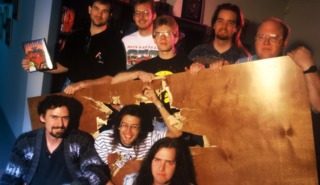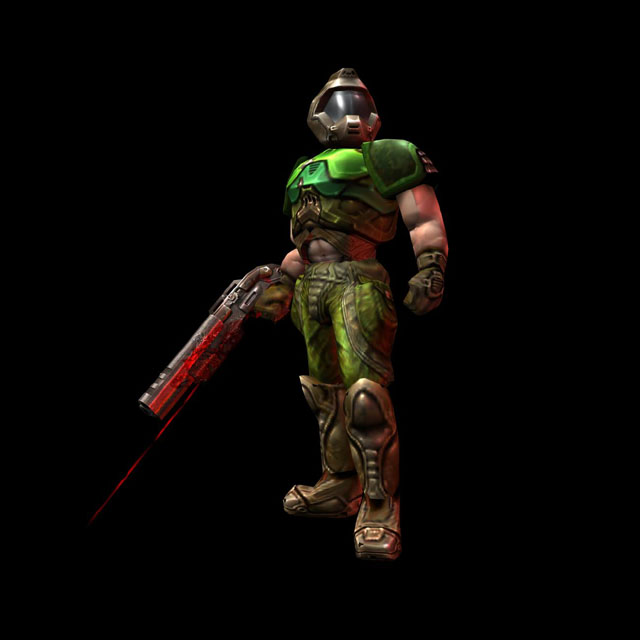The Legend of Doom
 The People of Doom!
The People of Doom!About eighteen months prior the release of Doom, id Software had released Wolfenstein 3D which had set the new standard of what would become the first person shooter genre. id Software had hoped to try and outdo their previous game with Doom. The goal with Doom was to improve upon the Wolfenstein formula in both graphic quality and game play. Even though Wolfenstein had in some cases crossed the status quo of gaming by fighting nazis and zombies, Doom pushed the envelope further by showing satanic imagery, increased gore, and demons as actual enemies, which provoked a lot of religious countries. At the time of Doom's release through shareware, the game had skyrocketed to more downloads than first expected.
Main Protagonist
Main article: Doomguy
 Doomguy as he appears in Quake 3 Arena
Doomguy as he appears in Quake 3 ArenaThe character that the player controls throughout nearly every game in the Doom series is an anonymous space marine, who, for lack of a real name, fans refer to as the "Doomguy". He appears to be very angry that the forces of hell have invaded his reality, which is understandable. He grits his teeth while shooting them, and is constantly on the look for more demons to murder. He seems to enjoy using weapons, as he shows a completely badass grin whenever he picks up a new one. He has a pet rabbit, which was tragically killed sometime before the final cutscene of the "Inferno" episode of Doom, appearing decapitated and with her head on a stick as a human city burns. However, he got revenge by killing lots of demons that invaded Earth, in the "Thy Flesh Consumed" episode of Ultimate Doom. Later, the Doom novels would give the character the name "Flynn Taggart", though the novels are of dubious canonicity.
Reception
It is estimated that the original shareware version of Doom had been installed on over 10 million computers by 1995. Doom II, which was not released as shareware, sold over 2 million copies.
As the success was rising so was the attention of those who would use the game as a poster child to show how video games were "destroying" or "corrupting" those who played video games. This was especially a hot topic after the Columbine High School incident in 1999 - at the time, the largest school shooting in American history. Eric Harris and Dylan Klebold, the two teenage killers, had been reported to have played Doom countless times to cope with anger or frustrations. It was also thought that Eric Harris had made levels in which he recreated Columbine High School to use as a sort of school shooting simulator. This was merely a rumour, while Harris did make Doom maps, none of them were like a classroom or school. Doom became a target, along with music artists such as Marilyn Manson and violent movies, for a country attempting to explain the motivation for the killings.
Sequels
 Blast more demons back to Hell
Blast more demons back to HellWith the initial success of Doom, id Software decided to put out a sequel to further improve the new established series. Doom II: Hell on Earth was the name of the sequel and it was not that much different from it's predecessor. The game still used the Doom engine and was essentially the same game just with a different story, newer enemies, and the double barreled shotgun as a new weapon. Doom II was released October 10th 1994, except this one would actually have to be purchased as it was retail. Much like the first one, Doom II was successful and went on to sell over 2 million copies.
Two years later, id Software made another installation of the franchise: Final Doom. Like Doom II before it, this sequel merely had a new story and maps. There were no new monsters or weapons. This one was considered a challenge Doom game for those who had beaten Doom II in its hardest difficulty. Ever since its debut on PC, Doom as been ported to many consoles or altered itself like the Nintendo 64 version, Doom 64.
This was the last seen to the Doom franchise in quite some time, since id Software had shelved the series to think about its future while working on the Quake series to further push PC limitations.
The Reboot

In June 2000, John Carmack announced that Doom 3 was in development. Doom 3 was a remake of the first game, depicting a demonic invasion of a human military installation on Mars. To the great surprise and disappointment of the franchise's fans, Doom 3 was a survival horror game, not a straight-out action game as its predecessors were. This game utilized the new id Tech 4 engine, which had been in development for quite some time.
The game was moderately well received, and an expansion pack was released entitled Doom 3: Resurrection of Evil. The expansion had brought back the fan-demanded double-barrelled shotgun and the new grabber weapon, which was inspired by Half Life 2's Gravity gun. In terms of story it continued right after Doom 3, with a new playable character, and even had the last boss be a key villain character from Doom 3.
Legacy and Future
The Doom franchise continued in May 2016 with the release of a long-in-development reboot of the series, simply titled Doom.
The Doom franchise has been essential to the development and popularity of the FPS genre - in particular "Run 'N' Gun" shooters. The series also became such a landmark in gaming, that a film was created bearing the same name. The film was not what fans of the series had hoped for, and it was not that well received by both fans and critics. Despite the movie, the lasting legacy of Doom has not only impacted the idea of what it meant for a game to be "run and gun", but the popularity of video games in general, especially on the PC. If someone were to compare its impact on games with a more modern game series from today, one could say Doom and Wolfenstein 3-D did to FPS's what the Grand Theft Auto series has done for the sandbox genre.
Doom is still greatly popular today, as people continue to play enhanced versions through source ports such as Zdoom and Skulltag, along with creating mods or WAD files for the series. With its lasting impact on video games in general, the Doom series is often hailed as one of video gaming's best and many believe the first two game's to be considered important to the further advance in video games as a whole or a popular culture.
Source Ports
Main article: Source Port
In 1997 the Doom source code was released to the public. It has lead to numerous 'source ports' including online multiplayer ports such as Skulltag, graphically enhanced versions with new textures and OpenGL support, and ports replicating the original Doom engine on modern hardware like Chocolate Doom.
PWAD
The most common add-on for Doom and Doom II are PWADs. WAD is an acronym of Where's All the Data? PWAD, or Patch WAD, is a file containing settings which can redefine or add content to the IWAD (Internal WAD - the core game data).
PWADs are loaded after IWADs and will therefore override the games default settings or add additional parameters. Custom maps are loaded as PWADs.
Trivia
- John Carmack, the creator of Doom, claims that the inspiration for the name of the original game came from the 1986 Tom Cruise movie The Color of Money. In a scene where Cruise's character Vincent Lauria arrives at a pool hall and is asked what he has inside his cue case, the cocky hustler replies with a grin: "Doom."
- The main Character has never actually been named in any Doom game, hence fans have referred to him as " Doom Guy"
- In every Doom game you play a lone space marine.
- Doom set the precedent for the set guns FPS today have, such as Shotguns, Rocket Launchers, etc.
- Many consider the term "Fragged" or "Fragging" to originate from Doom multiplayer.
- DeathMatch was first made in Doom.
- The main screenshot of Doom has the the main character holding a submachine gun, a weapon which is not in the final game.
- Doomguy appears in Quake III: Arena under the alias "Doom", and in Tony Hawk's Pro Skater 3 with bad air stats to indicate the original Doom did not have a jump button.
- The Doom soundtrack took inspiration (to the point of replicating riffs and hooks) from a wide variety of Heavy Metal music in the first two games from bands such as: Pantera, Slayer, AC/DC, Judas Priest, and Metallica to name a few.
- In Duke Nukem 3D, the player can find the Doomguy near satanic imagery and clutching his throat (much like the death animation in the game) with Duke remarking "that's one doomed space marine."
- The final boss in Doom II the "Icon of Sin", has a opening in the head which is the only way to hurt the boss, when in fact your actually damaging John Romero's head on a pike, which can be seen with a no-clipping cheat.
- In the Icon of Sin level in Doom 2, when you first encounter the main boss he will say a sentence that can't be understood, the reason is because it's a reversed speech. What he's actually saying is "To win the game, you must kill me, John Romero."
- The Pistol and Shotgun seen in the first few Doom games were digitized toy guns bought at a Toys "R" Us store.
- The Chainsaw in the original Doom games is a digitized McCulloch brand chainsaw.
- In 0.4 Alpha of the pre-release version of Doom, the player had a Rifle weapon and in Alpha 0.5 a rifle bayonet as melee weapon, both taken out of the final version of the game.
- The pre-release version of the original Doom had the Plasma Rifle fire red and green shots instead of blue, and the BFG9000 fired many shots horizontally instead of one giant shot.
- The textures in the game were mostly scanned images which were then digitized, one was of Adrian Carmack's snakeskin boots, another was of Kevin Cloud's wound on his knee.
- The hands and brass knuckles in the first few games were scanned hands from Kevin Cloud.
- The characters were made either made by hand drawn sprites or were sculpted by clay or latex then digitized and animated in the game. The characters in the game that were made from clay were the "Doomguy", the Cyberdemon and the Baron of Hell, by Adrian Carmack. While others like the Arch-Vile, the Mancubus, the Spider Mastermind and the Revenant, were created in latex and metal by Gregor Punchatz.
- There was a sixteen page, Doom comic printed in May 1996 featuring an obviously mentally unstable Doomguy searching for the BFG 9000.
- There was an open source modding tool created called DoomCAD which allowed players to create custom WAD files using the games existing assets and scripting logic. It supported custom graphics and sounds as well.
Log in to comment